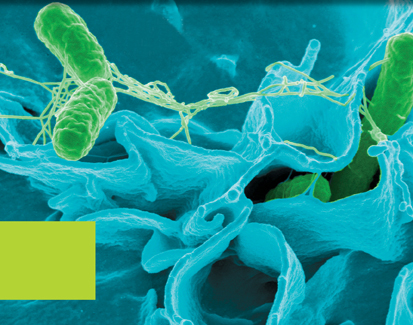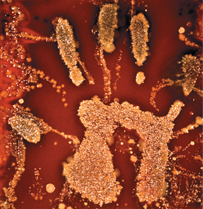Bacteria


Salmonella typhimurium (green) invading human epithelial cells (SEM 16,000X)
KEY CHARACTERISTICS
Bacteria are prokaryotes—cells that do not enclose their DNA in membranous nuclear envelopes as eukaryotes do. Many details of their molecular genetics differ from those of Archaea and Eukarya.
Cell Structure Variety of cell shapes, including spherical, rodlike, and spiral; most have cell walls containing peptidoglycan. Few if any have internal organelles. Some have external flagella for cell movement.
Genetic Organization All essential genes are in one large DNA double helix that has its ends joined to form a closed loop. Smaller loops of DNA (plasmids) may carry nonessential genes. Simultaneous transcription and translation; introns generally not present; histone proteins absent
Reproduction By binary fission; no true sexual reproduction; some achieve recombination by conjugation.
• Did You Know?
A World of Bacteria
Putting Bacteria in Proper Perspective
“Planet of the Bacteria” was the title of an essay by the late Stephen Jay Gould. He pointed out that the dominant life forms on planet Earth aren't humans, or animals, or plants. They are bacteria. They were here first, and they inhabit more places on the planet than any other form of life. In fact, bacteria make up roughly 10 percent of our own dry body weight! In terms of biomass and importance to the planet, bacteria truly do rule this planet. They, not we, are number one.

The bacterial colonies shown here are growing in the print of a human hand on agar gel.
Table of Contents
- Formulas and Equations
- Applying Formulas and Equations
- Mean, Median, and Mode
- Estimation
- Using Measurements in Calculations
- Effects of Measurement Errors
- Accuracy
- Precision
- Comparing Accuracy and Precision
- Significant Figures
- Calculating With Significant Figures
- Scientific Notation
- Calculating With Scientific Notation
- Dimensional Analysis
- Applying Dimensional Analysis




